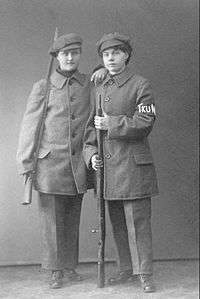Female Red Guards of the Finnish Civil War
| Women's Red Guards | |
|---|---|
|
Helena Aalto (b. 1898) and Elli Vuokko (b. 1890) of the Turku Women's Guard, both executed in May 1918. | |
| Active | February–May 1918 |
| Allegiance | Red Finland |
| Branch | Red Guards |
| Role | Combat units and Support services |
| Size | 2,000 members |
| Engagements | Finnish Civil War |
Female Red Guards were all-female units of the paramilitary Red Guards in the 1918 Finnish Civil War. More than 15 Female Guards units were established between February and March 1918 with the total number of women serving coming to approximately 2,000. The Guards were composed of young industrial workers, maids, and servants, with an average age of about 20, but included members as young as 14 years of age. The women served in auxiliary units as well as in combat.[1] At least 755 Red Guard women died in the war; 70–130 were killed on the battlefield, 420–460 were executed by the Whites, 80–110 died in the prison camps, and 180 went missing.[2][3] Captured women who were armed were usually shot soon after combat and often raped before the execution.[1]
History
Background
Finnish working-class women had been active in society since the late 1800s. The suffrage movement began in the 1890s. Since the beginning of the 1900s, women were a part of the movement against the Russification of Finland, organizing conscription strikes. Female laborers also played a major role in the 1905 general strike.[4] Although Finnish women gained the right to vote in 1906 (second in the world), women's social status still lagged behind men. For example, married women were under the authority of their husband and were not allowed to have a job without his permission.[1] The condition of working-class women was much worse than the role of middle-class women. The situation for maids and servants was especially poor. Because of the 1865 Imperial Servant Act, they lived in slave-like conditions often resulting in sexual abuse. Child labor was also legal in Finland until the 1920s.[5]
Formation
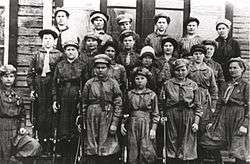
When the Finnish Civil War started in late January 1918, women were recruited to the Red Guards to perform supportive tasks like nursing, cooking and sewing. These jobs were usually done by elderly working-class women with a trade union and labor movement background. While the men were fighting in the front, the women secured their families' livelihood with a salary paid by the Red Guards. As a result, some younger labor women were willing to form units of their own, as they could not assist the troops otherwise.
The first Women's Guards units were born in the early days of February in Helsinki, Vyborg and Valkeakoski. The model came from the Women's Battalions of the 1917 Russian Revolution. At first, the Red Government and the Red Guard staff opposed the women's units, as did the antimilitarist Social Democratic Women's Union. On 13 March, the Red Government finally approved the guards already founded but ended the establishing of new units. This order, however, was not strictly followed and some new units were still formed in late March and early April in the largest towns and industrial communities of the Red controlled part of Finland. With a couple of exceptions, they were not established in the rural areas. Some women served in combat units, others were assigned to support duties. The armed women were given a short military training by the leading Red Guard personnel. At first they did guard duty, but in late March, the first ones were sent to the frontline.[1][6]
The core of the Women's Guards was composed of radical women, who wanted to create a more equal society and improve the status of women. The women demonstrated their radicalism by cutting their hair short and wearing unconventional outfits. They often rejected skirts and dresses which were seen as the traditional clothing for women. Many of the Guard members wore trousers, which at the time were worn by men only. Insurgence against traditional values meant that the women were hated by the bourgeois White side of the Civil War. The radical labor women did not fit into the role model of conservative middle-class society.[7] After the war, many of the women explained how they joined the Red Guards for the money, claiming the salary was higher than usual. These statements were not considered very reliable as they were given in the court hearings when the women were trying to avoid the sentence.[1]
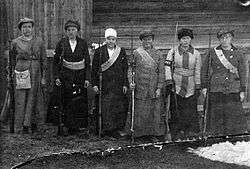
The total number of women who served in the guards remains unclear. The Red Guards payrolls include the names of 1,440 Women's Guards members but the lists are not complete.[8] According to the historian Ohto Manninen, the number was 2,000.[9] According to the upcoming 2017 book by historian Tuomas Hoppu, there was at least 2,600 members.[10] This was approximately 2–3% of the 90,000–100,000 Red Guard fighters. In addition, thousands of other women supported the Red Guards. After the war was over in May 1918, the Political Offence Court accused more than 5,500 women of being Reds, but the number in reality is much higher. Four thousand of the accused were convicted of treason, but with the exception of some of the leading Red women, all were pardoned in October 1918.[11]
Attitude towards Red women
By joining the Red Guards, women stepped out of their traditional role within Finnish society, something which the conservative Whites saw as a threat. The Whites defined them as indecent and immoral unfeminine women who were unfit for the roles of mother and wife. During the war, all sorts of malicious rumours were spread about Red Guard women. The White newspapers wrote how the Reds tortured all their prisoners, and castrated some. In reality, these allegations had no substance nor were ever supported by any evidence. Only one woman is known to have taken part in White executions, despite the fact that approximately 1,700 people were killed in the ″Red terror″. The Red nurses working in the field hospitals were mockingly called the ″sisters of love,″ insinuating that they were prostitutes.[7]
The hatred and disgust toward Red women was so harsh that they were often dehumanized and demonized. One of the most famous outbursts was made by the Finnish author Ilmari Kianto. He called the Red women "wolf bitches" who should be exterminated so they would not be able to "breed more of their kind." The newspaper Hufvudstadsbladet wrote that Red women should not be treated as prisoners of war, but should be "chased into the woods like animals." Another newspaper, Aamulehti, called them the "lowest scum" who must be cleansed from Finnish society. The archbishop Gustaf Johansson declared that Red women must be left "in the hands of Satan" and not helped in any way.[7] Women killed on the battlefield were often dishonoured, their corpses undressed and left with breasts and genitals uncovered.[12]
After the war, Red women were rejected by society for many years. Their role in the war was belittled for decades. A vast majority of the academic research on Red women has been made only since the 1990s.[7]
Combats
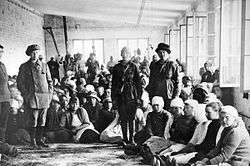
Women's Guards were used as the last reserve in the final stages of the war. In April, they took part in the defensive battles of Tampere, Helsinki and Vyborg, and the Battle of Antrea in the Karelian Isthmus.[11] The women who joined the Red refugees fleeing east also fought against the German troops in the Southern Tavastia region as thousands of refugees were trying to break through the enemy lines. Most famous was the Battle of Syrjäntaka in Tuulos on 28 April. More than 4,000 refugees were desperately clashing against the German lines with the Valkeakoski Women's Guard in the front row. In just a few hours, more than 300 Red Guard fighters and dozens of German soldiers died in a battle fought at a highway crossing. Finally, the Germans retreated as they ran out of ammunition. The German general Rüdiger von der Goltz later described the Red women in his memoir; ″Hardly have the Frenchmen ever attacked so fiercely as did these fanatical women.″ The women had already cleared the way for the refugees a day before in the village of Alvettula as they crossed a bridge held by the White troops. Just a couple of days after the Battle of Syrjäntaka, 20,000–30,000 Reds were captured near the town of Lahti.[1][13]
Executions
Approximately 420–460 members of the Women's Guards were executed during the final stages of the war. The largest mass executions took place in Lahti, where 20,000–30,000 fleeing Reds fell into the hands of the German and White troops in the end of April.[6] Up to 2,200 Red women were placed in the Hennala camp, where the battalion commanded by the infamous Estonian colonel Hans Kalm shot at least 218 women in early May. The number may be even much higher, for example, the ″Terror List″ created by the Labour Archives of Finland includes the names of 600 women, but their fate cannot be verified.[14] The largest single execution in Lahti was carried out in 9 May, when at least 100 Red women were shot.[15] According to the diaries of the German officer Hans Tröbst, they were shot with a machine gun in the wood near the Hennala Garrison. Tröbst describes how the surrounding trees were covered with spatters of brains.[16] A common procedure was that the women wearing men's clothing, such as trousers or any kind of military outfit, were directly considered to be armed fighters and shot without any hearing. Because of this, the women tried to get rid of their trousers and sometimes wore nothing but underskirts as they were picked from the crowd of captured Reds.[17]
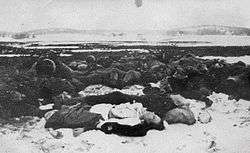
All those executed did not belong to the Women's Guards, the victims included women who had only joined the fleeing refugees. Among them were pregnant women and mothers of small children. The youngest shot were 14-year-old girls.[12] All the women executed in Lahti came from the provinces of Häme, Turku and Pori, and Uusimaa, mostly from the towns and municipalities of Alastaro, Forssa, Hyvinkää, Hämeenlinna, Lahti, Loimaa, Maaria, Mäntsälä, Pori and Turku.[17] Another well-known massacre is the execution of the Valkeakoski Women's Guard in the village of Hauho in 1 May.[6] In both cases, some of the women were raped before they were shot. The women imprisoned in Lahti were also extorted, with food given for sexual favours.[17]
The executions were carried out by the Finnish Whites. The Germans did not execute Red women, in many cases they were trying to stop the Whites from shooting their prisoners.[12] However, the Germans did take part in the sexual abuse of the captured women.[17] According to recent studies, the executions were an organized effort to "cleanse" society of the Red Guard women. The majority of executed women were industrial workers, who the Whites considered to be the lowest class of the society. The Guard members who had worked as maids or servants and came from the rural areas were not shot that often.[12] In Lahti, for example, the executed men were usually commanders and platoon leaders but in the case of women, the procedure was extended to ordinary fighters as well. The Red women were seen as a threat to the purity of the Finnish race. Colonel Hans Kalm, leader of the Lahti executions, was interested in the eugenistic ideas of Martti Pihkala and Lauri Pihkala, brothers who were among the main ideologists of White Finland.[14] In addition to the executions of the Red women, the Whites also conducted ethnic cleansing. The best known is the Vyborg massacre, the killing of more than 400 Russian civilians.[12]
Most of the unlawful executions, as well as those sentenced by temporary court martial, were finally stopped in late May. The prisoners were then brought to the newly established Political Offense Court which reduced the death sentences.[6]
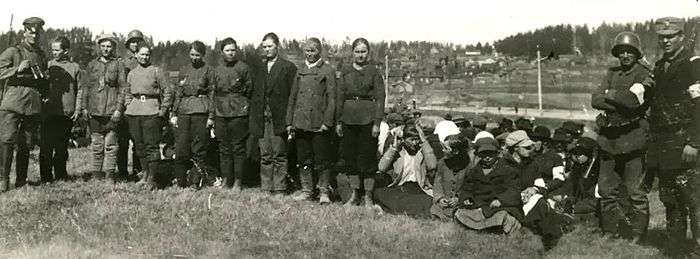
The largest units
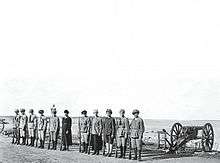
- Helsinki
Helsinki Women's Guard was the largest unit with 466 members.[13] The Guard fought against the German Baltic Sea Division in the Battle of Helsinki in 12–13 April, becoming famous in defending the Linnanmäki hill. Although, the recent studies have shown the fight has most likely been much exaggerated and it is a myth more than a reality.[6]
- Tampere
Tampere had two Women's Guards, one in the town and another in the suburb of Pispala. The Tampere Guard had 221 members[13] and the Pispala Guard, led by the 18-year-old peasant's daughter Emma Oksala, 40–50.[18] Tampere Guard is known the final hours of the Battle of Tampere in 5 April, as they defended the City Hall. The male fighters were already willing to surrender, but the women insisted them to fight for the last man standing. As the battle was over, only three women were shot. In Tampere, women were not executed despite the mass executions of more than 3,000 surrendered Reds. The White Guard staff prohibited the killing of women, most likely because of the large number of foreign citizens in town.[19]
- Valkeakoski
Valkeakoski Women's Guard had 155 members. It was mostly composed of the women working in the Tervasaari Paper Mill. Valkeakoski women became famous in the end of April, as the Red refugee column was fighting against the Germans on their way east. On 25 April, the guard took an important bridge in the village of Alvettula, located north of Hämeenlinna, and a couple of days later they fought against the German troops in the Battle of Syrjäntaka. Some of the women were captured after the battle and then handed over to the White Guards. More than 20 women were held in a barn for two days and possibly raped before they were shot in the village of Hauho. A total of 47 Valkeakoski women were killed in the war.[13]
- Vyborg
Vyborg Women's Guard fought in the Battle of Antrea and the Battle of Vyborg. The 151-member[13] unit was led by the 20-year-old Toini Mäkelä. After the war, she fled to Soviet Russia and formed a women's battalion fighting in the Russian Civil War.[20] Another Vyborg Women's Guard was formed in the port of Uuras by local labour women. The Uuras Guard occupied the Trångsund Fortress.[21]
- Turku
The Turku Women's Guard (also known as the Maaria Women's Guard) was composed of the women of the Turku suburb of Raunistula, who were part of the Maaria municipality at the time. The Guard had 113 members who first fought in the Battle of Tampere. After the towns collapsed, the Turku women fought in the Satakunta front and in the Battle of Lempäälä. Dozens of its members were later executed in the Hennala camp in Lahti as they were captured on their way to the east.[22]
References
| Wikimedia Commons has media related to Women's Red Guards of the Finnish Civil War. |
- 1 2 3 4 5 6 Lintunen, Tiina (2014). "Women at War". The Finnish Civil War 1918: History, Memory, Legacy. Leiden: Brill Publishers. pp. 201–229. ISBN 978-900-42436-6-8.
- ↑ Lindstedt, Risto (28 October 2011). "”Susinartut”: Naiset punakaartissa 1918 – kuvakertomus". Suomen Kuvalehti (in Finnish). Retrieved 19 January 2017.
- ↑ Eerola, Jari; Eerola, Jouni (1998). Henkilötappiot Suomen sisällissodassa 1918. Turenki: Tie Tammisaareen -toimikunta. pp. 28, 159, 173. ISBN 952-91000-1-9.
- ↑ Blanc, Eric (4 March 2015). "Revolutionary roots of women’s suffrage: Finland 1906 — an International Women’s Day tribute". Links International Journal of Socialist Renewal. Retrieved 28 February 2017.
- ↑ Pihlajamäki, Päivi (12 March 1997). "Palvelijattaret luudat tanassa. Helsingin Työväenyhdistyksen Palvelijatarammattiosasto - kyökkikomiteoita, Suomi-mielisyyttä ja Venäjän-vastaista taistelua". University of Helsinki (in Finnish). Retrieved 19 January 2017.
- 1 2 3 4 5 Hoppu, Tuomas (2008). "Sisällissodan naiskaartit". Työväentutkimus vuosikirja 2008. Helsinki: Työväenperinne – Arbetartradition ry. pp. 12–14. ISSN 0784-1272.
- 1 2 3 4 Lintunen, Tiina (2010). "″She Wolwes and Russian Brides″ – Women Enemies in War Propaganda". Proceedings of the 9th European Conference on Information Warfare and Security. Reading: Academic Publishing Limited. pp. 183–189. ISBN 978-190-66386-6-5.
- ↑ Lappalainen, Jussi T. (1981). Punakaartin sota 1. Helsinki: Valtion painatuskeskus. p. 159. ISBN 951-85907-1-0.
- ↑ Manninen, Ohto (1993). "Taistelevat osapuolet". Itsenäistymisen vuodet 1917–1920 osa 2. Taistelu vallasta. Helsinki: Valtion painatuskeskus. p. 138. ISBN 951-37125-4-0.
- ↑ "Kevään kirjat 2017". Gummerus Publishers (in Finnish). 8 November 2016. p. 38. Retrieved 19 January 2017.
- 1 2 Lintunen, Tiina (2009). "″A Danger to the State and Society″: Effects of the Civil War on Red Women's Civil Rights in Finland in 1918". Suffrage, Gender and Citizenship – International Perspectives on Parliamentary Reforms. Newcastle upon Tyne: Cambridge Scholars Publishing. pp. 177–192. ISBN 978-144-38016-2-1.
- 1 2 3 4 5 Liukkonen, Marjo (15 April 2016). "”Hennalan naismurhat 1918”. Lectio praecursoria 4.4.2016". Ennen ja nyt (in Finnish). Retrieved 19 January 2017.
- 1 2 3 4 5 Anttonen, Varpu (2009). Valkeakosken naiskaarti Suomen sisällissodassa 1918. Tampere: University of Tampere.
- 1 2 Puttonen, Mikko (1 April 2016). "Tutkimus sisällissodasta: Valkoiset teloittivat yli 200 punaista naista Hennalan vankileirillä". Helsingin Sanomat (in Finnish). Retrieved 19 January 2017.
- ↑ Lumme, Hanna (1 April 2016). "Tutkija: Totuus vankileirien kauhuista ei selviä koskaan kokonaan – "Tilastoja kaunisteltiin"". Yle News (in Finnish). Retrieved 19 January 2017.
- ↑ Tröbst, Hans; Troebst, Mario (ed.) (2015). "Der Krieg im Westen" Band 6: Der Marsch nach Estland und Finnland. Der Krieg im Westen und das bittere Ende. Hamburg: Mario Troebst. p. 169. ASIN B00SYVVEUW.
- 1 2 3 4 "Tutkimus: Rotuhygienia innoittajana Suomen suurimpaan naismurhaan". University of Lapland (in Finnish). 1 April 2016. Retrieved 19 January 2017.
- ↑ "Pispalan Naiskaarti – nuoria tyttöjä vartiotehtävissä". Punainen Pispala (in Finnish). Retrieved 19 January 2017.
- ↑ Roselius, Aapo (2006). Amatöörien sota. Rintamataisteluiden henkilötappiot Suomen sisällissodassa 1918. Helsinki: Prime Minister's Office of Finland. pp. 31–51. ISBN 978-952-53549-2-8.
- ↑ Katainen, Elina (11 October 2005). "Mäkelä, Toini (1895-1973)". The National Biography of Finland (in Finnish). Retrieved 19 January 2017.
- ↑ Leppänen, Veli-Pekka (10 November 2013). "Verenpunainen Viipuri, valkoinen voitonnäyttämö". Helsingin Sanomat (in Finnish). Retrieved 19 January 2017.
- ↑ Hakala, Anu (2006). Housukaartilaiset. Maarian punakaartin naiskomppania Suomen sisällissodassa. Helsinki: Like Publishers. ISBN 952-47187-9-0.
